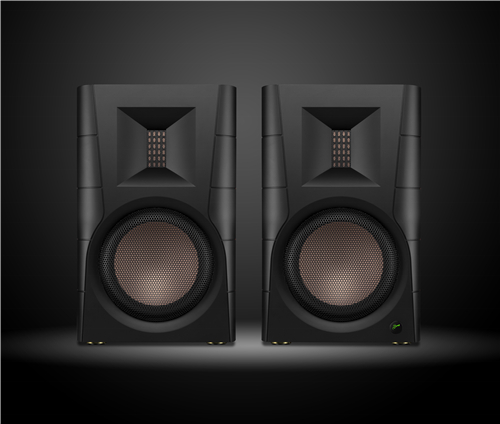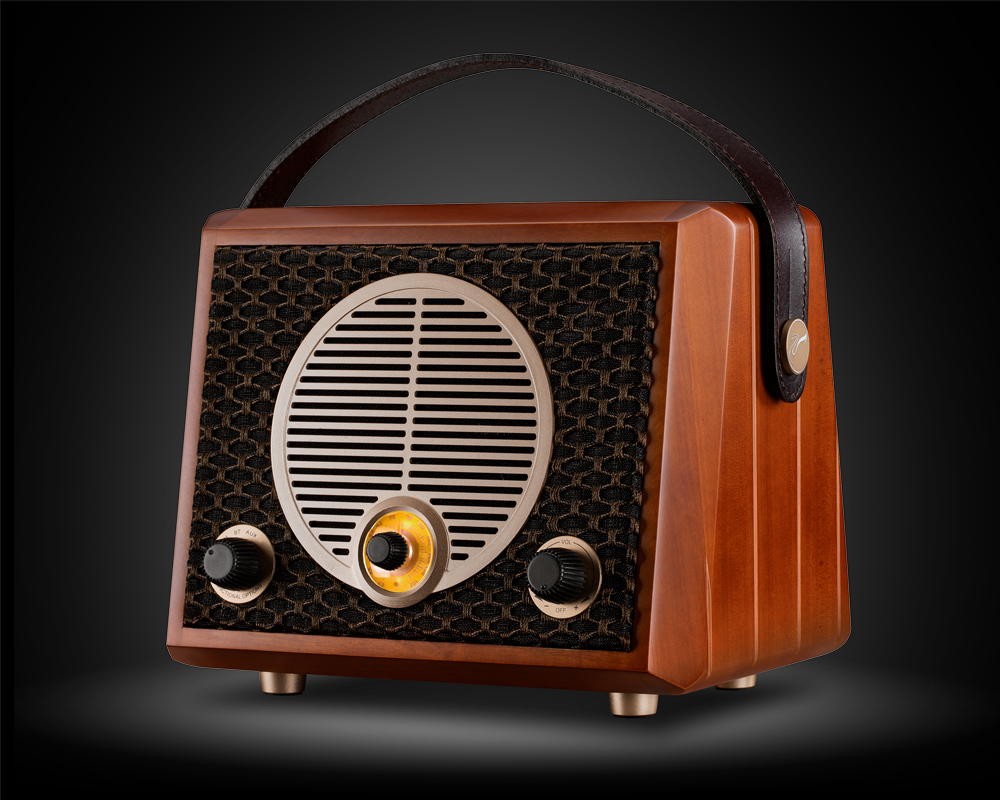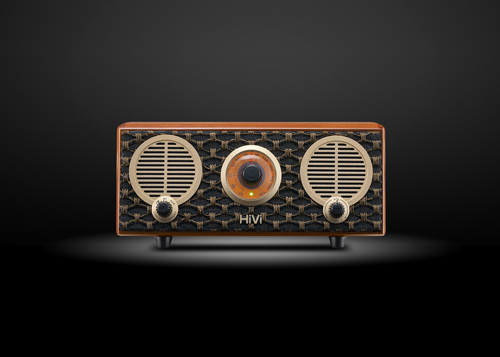Interview with design master Mr. Hale
At the '96 Consumer Electronics Show held in Las Vegas, USA, Mr. Yao Hongbo, President of ACOUSTIC TECHNOLOGY INTERNATIONAL INC (ATII), visited Mr. Hale, President and Designer of Swans Speaker System. Swans is a world-renowned loudspeaker company, renowned all over the world for its superb woodworking skills. Mr. Yao entrusted Mr. Hale to design a cinema system for Swans using Swans speaker units. To learn more about the designer and the system, we spoke with Mr. Hale.
"Mr. Hale, could you please introduce yourself and tell us how you came to deal with making speakers?"
"Well, we have a platform saw in the basement of our house, and I learned how to use it as a kid. As you can imagine, my mom was always worried about that. I took the speakers out of the old radio and put them in my hands. One time, I made a box design that looked most like a transmission line, and I was very excited because I thought I had invented a new type of speaker. Later, someone told me that someone else had already invented it, which made me I was disappointed at the time. I was expecting myself to be a famous thirteen-year-old speaker designer. After high school, I went to Ontario College of Art and Design and became a professional designer. I love working with wood, and the truth is finally Shows that designing speakers full-time is a natural extension of my talents."
"What music are you listening to now?"
"It depends, I think. My home is in the countryside, overlooking a small inlet. There is a gazebo on one side of the house, and I put a pair of speakers in it. I spend a lot of time listening to choral music on summer evenings. .It's wonderful to be outside on a warm summer night listening to music while watching the moon pass over the water. I love blues, jazz, old rock from the fifties and sixties. I've been listening to a lot of three Music played by big bands in the 1900s and 1940s."
"You must be very busy running your own company. Why did you decide to accept Mr. Yao's request to design a cinema system?"
"I liked Mr. Yao as soon as I saw him. We were like two kids, excited about what we were doing. He gave me total freedom to do whatever I wanted, which was very unusual. Average Companies tend to design their products on the basis of using the cheapest speaker units possible and making as much money as possible. This is especially true of cinema systems. But that’s definitely not the case here with Mr. Yao.”
"Can you tell us a little bit about how you designed this theater system?"
"The first thing I did was to visit the HiVi company in Toronto, and discuss with the speaker unit designer about the various types of drivers HiVi produces. We narrowed the selection down to five or six types of speaker units.
When I got home, our factory made a series of rough cabinets for basic crossover design. I measured various cabinet combinations and entered them into a computer design software called Dul'cet. I can use this software to predict the best divider. Of all the combinations, I found two that seemed to perform well. I made several crossovers and after listening to them many times, I settled on the one that sounded the best. Then I did a lot of sketches in pencil and modeled the speaker system. The next step is to draw the drawings with AutoCAD. The drawings are then sent to our box workshop for fabrication. If you find something different from the design that might be problematic, the guys will make a mockup before finalizing it. These people are very competent and can usually handle all the tasks you give them.
When the sample boxes were ready, I moved them to the laboratory upstairs. The speaker units and crossovers have been tuned to good condition using computer software—the same kind of software NASA uses to test circuit components on satellites. That's the equivalent of leaving the speaker system on for four months straight. Then, I listened and tested and made some additional fine-tuning of the crossover board. If I am satisfied with the design and sound quality, they are sent to Inspection and Packaging to be tested again. From an aesthetic point of view, I generally have to compare three complete samples before I am completely satisfied with the design. It takes an average of six to nine months to complete a system. "
"What's the difference between designing a system that plays music and designing a home theater sound system?"
“It depends on what frequency range you’re talking about. Whether it’s used in a stereo or in a theater system, the midrange and treble should be high quality. Some people believe that the quality of speaker units used in a home theater system is not That's so important. Salespeople usually use this theory to sell a whole system that includes low-quality speakers. Customers buy them and take them home, excited to have a theater system. They After listening to it for two weeks, I began to realize that the speakers were always uncomfortable for some reason. Every time they sat down to watch a movie, the problems with the speakers kept distracting them. Since the speakers have the greatest impact on the quality of the sound, So you should take this very seriously. I often advise people that if you can't afford a decent full surround system, start by buying a pair of front satellite speakers and a good subwoofer. If you can afford it Affordable, you can add center speakers and rear speakers. In a theater system, bass is much more important than a sound system dedicated to listening to music. People generally like to have more bass when listening to a theater system. In movies In recordings of 2019, the bass is an important factor in conveying the sense of dynamics. It would be nice to have some way of controlling the volume of the bass so that you can adjust the volume to a level that is comfortable for you.”
"What kind of audio-visual equipment can be equipped with the design of this Duchy 5.1a system?"
"Depending on the speakers you're using, this system can be used with Dolby ProLogic or Dolby Surround AC3. Front and center speakers will work in both, but for AC3, you'll need to buy the rear speakers Duchy 2.1c. They are front Inverted, it can be mounted on a shelf or on the wall behind. In Dolby Pro-Logic, you use surround speakers. They are dipoles and can be mounted on the wall or on the shelf on either side of the listener.”
"What speaker unit did you use in the Duchy 5.1a cinema system?"
"I really like the SD1.1 tweeter. It's a one-inch soft dome, free and open, with excellent transient response that rivals the best soft domes available today. The low-mid frequency driver uses It's the Hi-Vi-D6C. It's a beautiful driver with a huge three-inch voice coil and cast aluminum frame, with great dynamics. I'm guessing it's the result of the large voice coil and hard cone. The subwoofer is a ten inch E10 woofer. I was surprised when I auditioned the E10, this woofer is better than many woofers that cost three times as much. It's a very good woofer and it's shielded!
For all the front speakers, I use the D'Appolito method. I have had many successes with this equipment. As long as the crossover is suitable, this setup produces a very wide and even soundstage over the entire listening range. While this setup was originally known for being used in premium sound systems, it is more suitable for home theater systems, especially if you have a group of people sitting side by side on the front listening surface. This system allows you to have a more realistic feel, for example, of gunshots and crashes. The dynamics are breathtaking, as if the entire wall is emitting sound. We use the same speaker units throughout the system. This is necessary for surround sound if you want to get the best out of your system. Many systems rely on a single subwoofer housed in a separate enclosure, so I decided to install a self-amplified subwoofer in each of the two front-facing satellites. This produces better bass reproduction. In Jurassic Park, the scene where the T-Rex slowly approaches a broken down car has incredible sound effects. With every step the T-Rex took, I could feel the floor vibrate. Each subwoofer has a 100-watt active subwoofer amplifier that only activates when it senses a signal entering the main speaker. You can simply adjust the volume of the bass at will. The center speaker is an open-ended design, adding weight and authority to some male voices. "
"About the crossover, is there anything you can tell us?"
“In general, I think the crossover design should be effective. The crossover for this system uses high quality Duchy capacitor components and has a tuned group delay. Over the years, I have discovered many tricks that add Together they produce a realistic soundstage. The real test is to listen to those speakers with high-quality speakers, such as the ones in our lab. I am very satisfied.
"Can you tell us something about the structure of the system?"
“All the cabinets are made of special 20mm acoustic panels with ebony veneer on the outside. The cabinets are supported by a number of brackets. Each mid-range speaker in the front main speakers In the six" duct at the rear of the cabinet. There are two reasons for this, as you know, the sound radiates equally from the front and the back of the cone. If left untreated, the sound radiated from the back is in the cabinet Reflection, then back through the speaker unit, or radiate out of the side walls in the form of cabinet resonance. Cabinet resonance affects music and dialogue more than most people know. Install the speaker unit In the duct in the cabinet, cabinet resonances in the lower mid-frequency region are almost eliminated. Second, the sound waves bouncing around in a circular duct are softened compared to the reflected waves in a typical box cabinet many."
"The front baffle of the cabinet is designed in a stepped lamination shape, which is very beautiful. Does this affect the sound?"
"Yes. Acoustic damping material is glued to each layer, making the structure around the speaker unit less likely to resonate. The midrange speaker is installed slightly ahead of the tweeter. This arrangement, coupled with the crossover delays, resulting in a favorable phase adjustment in the crossover region.”
"I was just listening to the individual effects of the rear speakers 2.1c - fantastic. Can they be used in a normal music Hi-Fi sound system?"
"Certainly. They're open-ended and have amazing low-end volume. You could mount them on a back wall or on a shelf in another part of your home and use them as speakers specifically for listening to music. Try it out, install them Outside on the patio, listening to choral music at night, you'll see what I mean."
"What advice do you have on the power of the amplifier?"
"The front and center speakers are at least 100 watts per channel, and the rear and surround speakers are at least 60 watts. The subwoofers are self-amplified, so don't worry about that."
Thank you very much for accepting our interview. This interview article will be published in the most influential audio magazine in China. I believe that many Chinese readers will re-experience the modern The real charm of home theater!




